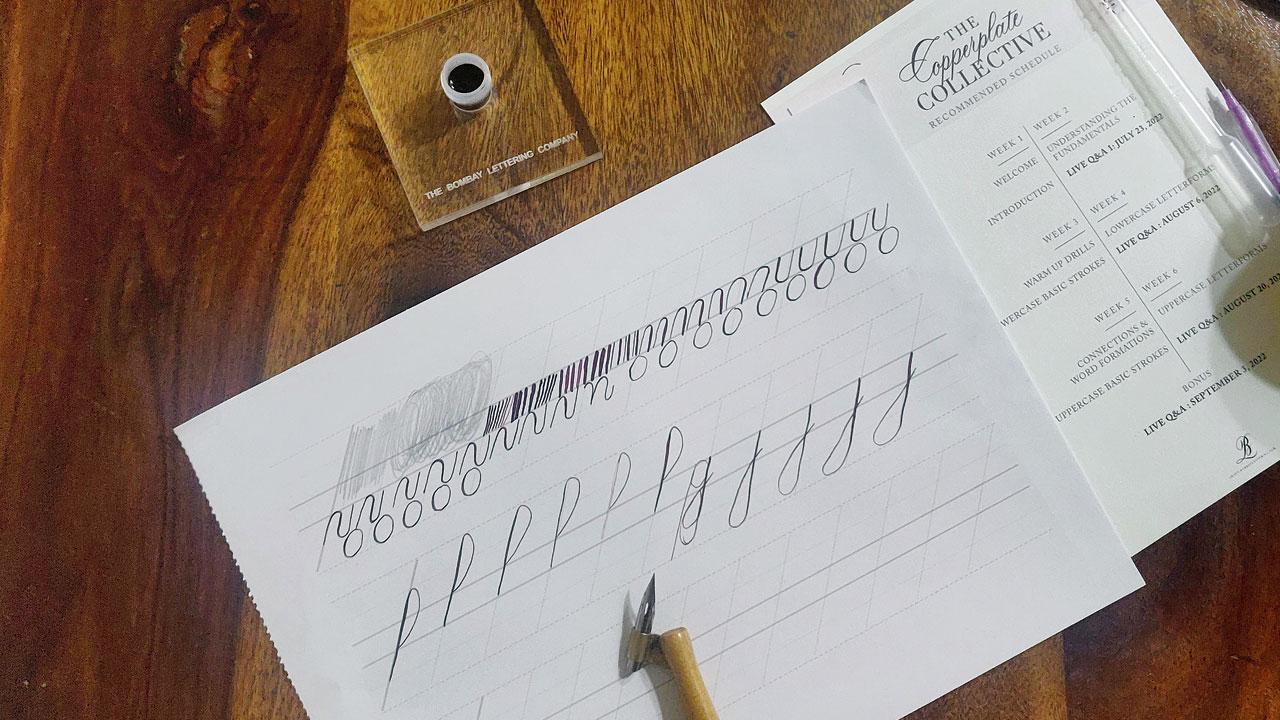We tried out an online copperplate script course, and the experience was enriching

The Copperplate Collection kit
Do we need great handwriting to try calligraphy? “Absolutely not,” Sanjana Chatlani, founder of The Bombay Lettering Company, laughs, putting us at ease. “When we write, we share our thoughts on paper.
ADVERTISEMENT
With calligraphy, you are focusing on each stroke to create a style. Practice matters,” she adds. We signed up for her online offering, The Copperplate Collection, an online self-learning video course on the elegant Copperplate script that originated in England.
Our kit is a thoughtful curation, and includes a personalised bookmark and cranberry tea. Supplies include an oblique holder, two nibs, ink, instruction cards, a recommended schedule, a brown practice pad, and a black binder with worksheets to trace over. “The script skeleton is based on oval strokes. In everything that we do, we are thinking of ovals and slanting lines. The nib splits open on pressure to create a thick line. The hairline stroke is always upwards, and the downward course is pulled down with pressure,” Chatlani explains.
A former marketing executive, her interest in calligraphy began when a gentleman visited their office to write handwritten cards. Copperplate calligraphy intrigued her. “In 2017, I realised this was my calling, and started the Bombay Lettering Company. When people take my course, I want them to use it practically — write a note or set a dinner table with name cards. I will also conduct live sessions to answer questions,” she adds.

Our test handwriting
Go with the flow
We follow her instructions — our feet are firmly on the ground, a slight turn of the body to the left, with the worksheet at an angle so that the lines are perpendicular to our stomach; the nib is always aligned to the slant of the paper lines. A stroke on the worksheet begins at the baseline, going up to the waist line; over which are the first and second ascenders. Below the baseline, sit the first and second descenders. Before we begin to work with the nib, we scribble some strokes and ovals on the paper to free up our movement. We fit the nib into the flange, pour ink with a dropper and plunge the nib halfway. We set our angle and begin gentle upward strokes that are shaky. The downward thicker stroke flows well and the nib splits open when we apply pressure, releasing more ink. Next, we connect them with an overturn, learn the oval and try an ascender loop. Every stroke needs attention; it is therapeutic, making us shut out the world.

Sanjana Chatlani
A stroke online
We dabble with the script for the next few days. After the fundamental strokes and the videos, the lower and upper cases are divided into groups, clubbing similar letters for easy learning. Bonus videos include punctuations, variations, layouts and compositions. We’ve written the letters. Our vertical loop needs work, and looks like scribbles; however this process has opened up a creative world. Calligraphy is like a classical dance form; abide by the rules and master the strokes, as it follows a strict style. There are forms, skeleton shapes, and once you’ve aced it, a unique art and style will emerge.
Log on to: bombaylettering.com
Cost: Rs 8,499 onwards
 Subscribe today by clicking the link and stay updated with the latest news!" Click here!
Subscribe today by clicking the link and stay updated with the latest news!" Click here!








